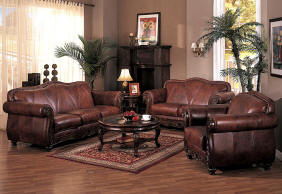How to effectively
'show' your home
Showing your home is
a lot like a first date: You get
your house all gussied up, put the
prettiest face possible on the
property and try to impress the heck
out of someone you barely know --
the potential buyer. The objective,
however, is not to get a phone
number or a peck on the cheek. It's
to make a sale, which in most cases,
is a far greater challenge.
But showing a home does not have to
be an overwhelming, costly process.
Regardless of your home's size, age,
style, and location, there are ways
to spruce it up and effectively
showcase its assets. So grab your
paintbrush, carpet cleaner, lawn
mower, and Lysol -- the four
ingredients to a great first date --
and get to work on your house.
The condition of
your home is one of three factors
that influence a buyer's decision. Unlike location,
this is one factor you can control. But the idea is "not to
improve the condition of your home
to your liking, but to improve it to
sell it."
Creating good
flow ....
There are
four main areas of the home sellers
should focus on.
The first is the
entryway. "That is your first
impression of the house. Anything
visible from this standpoint needs
to look great. If you
don't impress them immediately it
will be an uphill battle from then
on to regain their interest.
The
family/living room, kitchen, and
master bedroom are the three other
crucial areas.
The key to
showcasing these rooms is to create
good flow. Buyers want to move
easily from one room to the next. But at the same time, they
need direction. It's important to
assign each room a purpose. she says.
Even though you may use your formal
dining room as your office, you must
show the dining room with its
intended purpose.
De-personalizing
Sellers should personalize the
experience for the buyer. The
buyers have to be able to see past
your life and your stuff so they can
visualize what it would be like for
them to live in your home.
Minimizing clutter and packing up
personal belongings helps them do
that.
There are two
schools of thought on
de-personalizing your home. A lot
of people say to take down the
family photos, but I disagree.
You're not fooling anyone by
pretending you don't live there. However,
I would recommend that wedding and
graduation photos, as well as
collections (i.e. stuffed animals,
teapots), be removed. Those are too
personal.
On the other
hand, anything that could
potentially pose a distraction
should be put away. "Buyers only
spend 10 to 15 minutes in a home.
You don't want them to be distracted
by unimportant details like personal
mementos. That won't help you sell
your house," she says.
Cleanliness
is godliness
At the same time, it's not possible
to fully neutralize a home that's
being occupied. Furthermore, "vacant
houses do not show well. A room
looks smaller without furniture and
stuff in it. But it
must be understood that each person
has a different sense of style. That
style is often reflected in the type
of furniture one chooses and in the
way that it is arranged. As long as
the house is clean and
well-maintained, buyers can look
beyond the furniture style, but it's
hard to look past a lot of outdated
wallpaper or too many intense wall
colors. |


